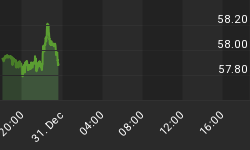The following is part of Pivotal Events that was published for our subscribers February 24, 2016.
Signs of The Times
"A parcel of land sold by the [Hong Kong] government went for nearly 70% less than a similar transaction in September."
- Bloomberg, February 14.
"This is a Wall Street Recession"
- Business Insider, February 16.
"Governments in the U.S., Europe and elsewhere should take 'urgent' and 'collective' steps...to boost flagging economic growth."
- OECD, Wall Street Journals, February 17.
"The IPO market is foundering"
- Wall Street Journal, February 18.
"House Flipping: Deja Vu All Over Again"
- CNBC, February 18.
"The recent steep declines in the prices of stocks and junk bonds are not the precursor of an economic downturn."
- Martin Feldstein, Wall Street Journal, February 21.
Perspective
Two of the headlines from the WSJ are pleas from economists for some sort of a philosopher king to fix things. Feldstein spent decades as head of the NBER and should know that financial setbacks precede recessions. Indeed, the pitch behind the formation of the Fed was just that. Intervention would prevent the market dislocations that prompted recessions.
In a non-bubble world, the cycle for share certificates would lead the cycle for business activity by some 12 months. In a world of financial bubbles the recession starts virtually with the financial setback. Using NBER data, the recession started in October 1873 and the
Bubble peaked in that fateful September. The recession started in August 1929 as the NYSE peaked in September, which for the record was also fateful. Stocks peaked in October 2007 and the recession began in that fateful December.
Also the NBER keeps the record on when the recession actually started and when the determination was announced. Usually a year after the melancholy event.
Most of our readers are familiar with this, but it is worth repeating. After all, the establishment continues with the mantra that central bankers can always prevent contractions.
We are cautiously pessimistic about the US economy.
Precious Metals
The opposing action between gold and orthodox sectors is becoming more apparent. Earlier today, the HUI was up 4.5% as the S&P was down 1.5%. The BKX was down 3.3%.
This is early in the next phase of contraction and a widespread liquidity crisis could eventually pull down most gold stocks. However, in 2007 golds were up with the booming stock market. But beginning in 2011 precious metals suffered a severe bear market as orthodoxy ascended to the Great Complacency.
On the longer term, the 2011 peak for HUI was 638 and the low was 99 in January.
As the golds were peaking in 2011 the S&P was at 1100, which ultimate high was 2134 in May 2015.
On the bigger picture, the feature of the post-bubble world has been diminishing profitability for most industry and commerce. This has been accompanied by improving profitability for gold mining.
Weakening commodities usually indicate weakening S&P earnings. But when they decline relative to gold it represents improving earnings for gold miners.
One proxy represents both worlds.
The gold/crude index set a cyclical low at 11.71 in June 2014. The high for the move was set a couple of weeks ago at 46.30, which represents a material drop in energy costs.
Just a guess, but perhaps the big mistakes made by industry leaders in the "forever" boom that peaked in 2011 have been written off. Gold mining can enjoy many years of improving operating margins.
As we have been noting over the past few months, a cyclical bull market for the precious metals sector has been building.
Iron Ore Price

- The low was 38 in mid-December.
- At 52 the rebound is becoming "straight up".
- The short squeeze is impressive and close to concluding.
Link to February 26, 2016 Bob Hoye interview on TalkDigitalNetwork.com: http://talkdigitalnetwork.com/2016/02/germany-has-it-right-no-more-stimulus/
Listen to the Bob Hoye Podcast every Friday afternoon at TalkDigitalNetwork.com
















